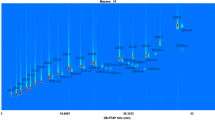Abstract
For quantitation ofcis- andtrans-fatty acid isomers, infrared (IR) spectroscopy, gas-liquid chromatography (GLC) on highly polar stationary phases or the combination (GLC-IR) may be used. IR offers the advantage of simplicity and speed, but the lower determination limit of 5% and the lack of detailed information limit its use. Detailed fatty acid information, required for, e.g., food-labeling purposes, can only be obtained with GLC methods. Most of the GLC methods are optimized for partially hydrogenated samples. AOCS Official Method Ce 1c-89 prescribes a single, highly polar stationary phase, SP2340, but underestimates the amount oftrans isomers due to 18∶1 positional isomer overlap. The combined GLC-IR method may circumvent this problem but at the cost of time, effort, and precision.Trans isomers in refined (deodorized or stripped) oils are different in type and levels from isomers in partially hydrogenated oils; theirtrans isomers are mono-trans trienoic and dienoic isomers, occurring at levels up to about 1–3%. GLC conditions for hydrogenated samples are often not suitable for refined oils because of overlap problems, but this time in the 18∶3 region. Through careful selection of stationary phase and temperature program optimization (Drylab®GC), we have developed a single method that is suitable for hydrogenated, as well as refined, processed oils. The accuracy was checked withcis andtrans fatty acid fractions isolated by silverion exchange high-performance liquid chromatography. Thetrans values obtained with the optimized method are in good agreement with the results obtained for the isolated fractions. We propose that recommended methods describe GLC conditions in terms of separation criteria rather than recommending only a fixed combination of stationary phase and temperature program.
Similar content being viewed by others
References
Enig, M.G.,Trans Fatty Acids in the Food Supply: A Comprehensive Report Covering 60 Years of Research, Enig Associates, Inc., Silver Spring, 1993, pp. 63–107.
Dutton, H.J., Hydrogenation of Fats and Its Significance, inGeometrical and Positional Fatty Acid Isomers, edited by E.A. Emken and H.J. Dutton, The American Oil Chemists’ Society, Champaign, 1979, p. 1.
Official Methods and Recommended Practices of the American Oil Chemists’ Society, American Oil Chemists’ Society, Champaign, revised 1990, revised 1991, updated 1992, Method Ce 1c-89.
Ratnayake, W.M.N., and J.L. Beare-Rogers, Problems of Analyzing C18 cis- andtrans-Fatty Acids of Margarine on the SP-2340 Capillary Column,J. Chromatogr. Sci. 28:633–639 (1990).
Ratnayake, W.M.N., AOCS Method Ce 1c-89 Underestimates thetrans-Octadecenoate Content in Favor of thecis Isomers on Partially Hydrogenated Vegetable Fats,J. Am. Oil Chem. Soc. 69:192 (1992).
Official Methods and Recommended Practices of the American Oil Chemists’ Society, American Oil Chemists’ Society, Champaign, 1993, Method Cd 14b-93.
Firestone, D., General Referee Report, Committee on Food Nutrition, Fats and Oils,JAOAC Int. 77:151–154 (1994).
Ackman, R.G., S.N. Hooper, and D.L. Hooper, Linolenic Acid Artifacts from the Deodorization of Oils,J. Am. Oil Chem. Soc. 51:42–49 (1974).
Devinat, G., L. Scamaroni, and M. Naudet, Isomérisation de l’acide linolénique durant la déodorisation des huiles de colza et de soja,Rev. Corps Gras 27:283–287 (1980).
Wolff, R.L., Further Studies on Artificial Geometrical Isomers of α-Linolenic Acid in Edible Linolenic Acid-Containing Oils,J. Am. Oil Chem. Soc. 70:219–224 (1993).
Wolff, R.L., and J.-L. Sebedio, Geometrical Isomers of Linolenic Acid in Low-Calorie Spreads Marketed in France,68:719–725 (1991).
Wolff, R.L., Heat-Induced Geometrical Isomerization of α-Linolenic Acid: Effect of Temperature and Heating Time on the Appearance of Individual Isomers,70:425–430 (1993).
Wolff, R.L., Analysis of Alpha-Linolenic Acid Geometrical Isomers in Deodorized Oils by Capillary Gas-Liquid Chromatography on Cyanoalkyl Polysiloxane Stationary Phases: A Note of Caution,71:907–909 (1994).
Scholfield, C.R., Gas Chromatographic Equivalent Chain Lengths of Fatty Acid Methyl Esters on a Silar 10C Glass Capillary Column,58:662–663 (1981).
Official Methods and Recommended Practices of the American Oil Chemists’ Society, American Oil Chemists’ Society, Champaign, revised 1969, re-approved 1989, updated 1992, Method Ce 2-66.
Author information
Authors and Affiliations
About this article
Cite this article
Duchateau, G.S.M.J.E., van Oosten, H.J. & Vasconcellos, M.A. Analysis ofcis- andtrans-fatty acid isomers in hydrogenated and refined vegetable oils by capillary gas-liquid chromatography. J Am Oil Chem Soc 73, 275–282 (1996). https://doi.org/10.1007/BF02523420
Received:
Accepted:
Issue Date:
DOI: https://doi.org/10.1007/BF02523420




